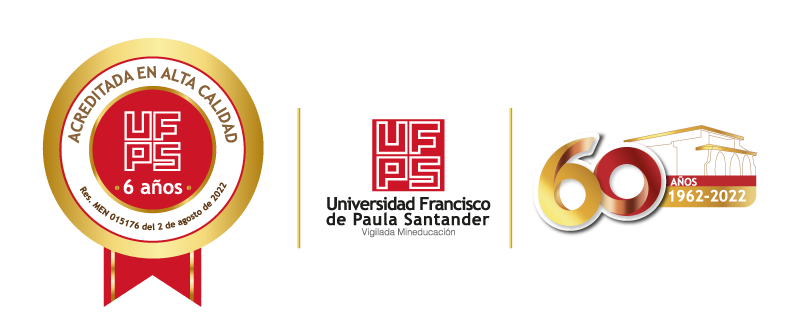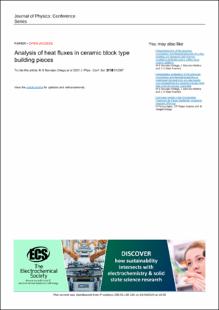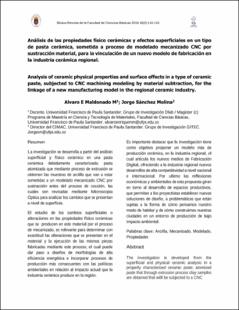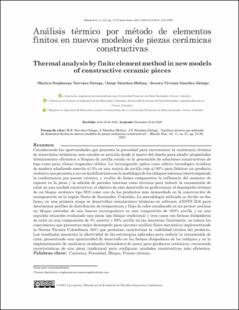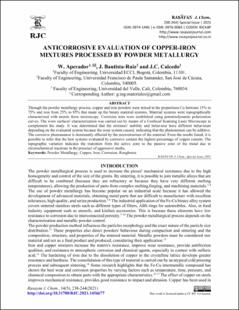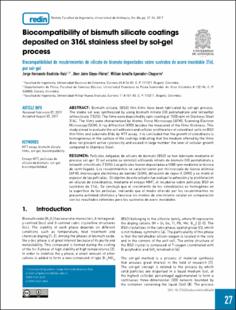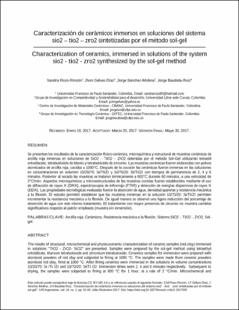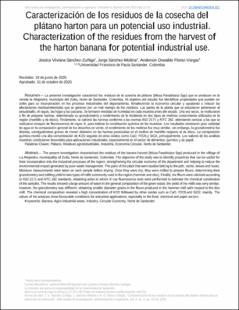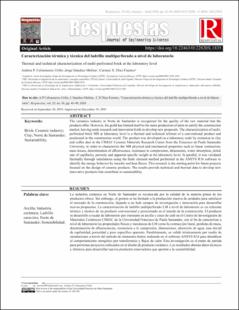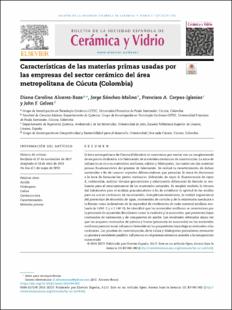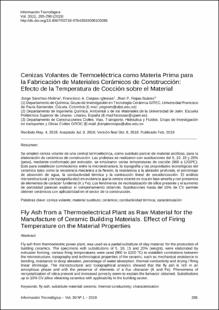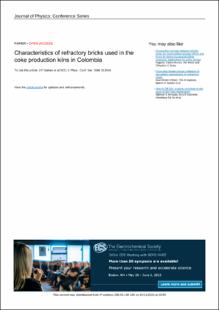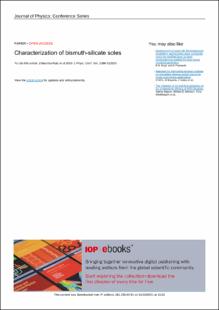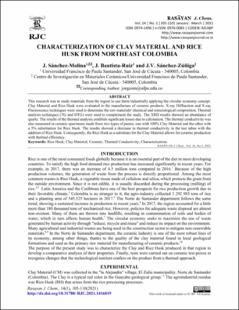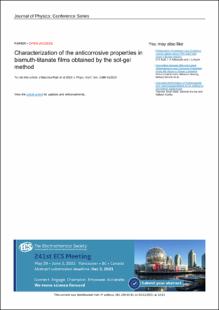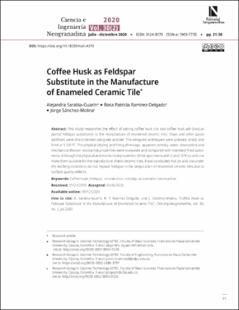Listar Tecnología Cerámica – GITEC por título
Mostrando ítems 1-20 de 93
-
Analysis of heat fluxes in ceramic block type building pieces
(Journal of Physics: Conference Series, 2021-09-02)In Norte de Santander, Colombia, there is a ceramic cluster made up of 59 companies dedicated to the production of construction materials derived from clay, a vernacular material with a wide extraction potential in the ... -
Análisis de las propiedades físico cerámicas y efectos superficiales en un tipo de pasta cerámica, sometida a proceso de modelado mecanizado CNC por sustracción material, para la vinculación de un nuevo modelo de fabricación en la industria cerámica regio
(Bistua Revista De La Facultad De Ciencias BasicasBogota , Colombia, 2018)La investigación se desarrolla a partir del análisis superficial y físico cerámico en una pasta cerámica debidamente caracterizada; pasta atomizada que mediante proceso de extrusión se obtienen las muestras de arcilla que ... -
Análisis térmico por método de elementos finitos en nuevos modelos de piezas cerámicas constructivas
(Mundo FescColombia, 2021-01-01)Considerando las oportunidades que presenta la porosidad para incrementar la resistencia térmica de materiales cerámicos, este estudio se articula desde el marco del diseño para añadir propiedades térmicamente eficientes ... -
Anti-corrosive characterization of silicon, titanium, and zirconium oxide coatings deposited on aeronautical aluminum substrates via sol-gel
(Journal of Physics: Conference SeriesInglaterra, 2020-12)Currently, aircraft wings made of AA2024 T3 aluminum are primed between the aluminum substrate and the outer layer of paint to improve the material's adhesion and corrosion resistance. This type of primer contains chromates ... -
Anticorrosive evaluation of copper-iron mixtures processed by powder metallurgy
(Rasayan Journal of ChemistryIndia, 2021)Through the powder metallurgy process, copper and iron powders were mixed in the proportions Cu between 15% to 75% and iron from 25% to 85% that made up the binary material systems. Material systems were topographically ... -
Biocompatibility of bismuth silicate coatings deposited on 316L stainless steel by sol-gel process
(Revista Facultad de IngenieríaColombia, 2017-09-25)Bismuth silicate, (BSO) thin films have been fabricated by sol–gel process. The stable sol was synthesized by using bismuth nitrate (III) pentahydrate and tetraethyl orthosilicate (TEOS). The films were deposited by ... -
Caracterización Anticorrosiva y de Biocompatibilidad en Recubrimientos Silicio-Titanio-Zirconio Sintetizados Vía Solgel y Depositados sobre Sustratos 316L
(Informacion TecnologicaSantiago de Chile , Chile, 2018-02)Se sintetizaron, los sistemas ternarios [Si/Ti/Zr: 10/70/20] y [Si/Ti/Zr: 10/20/70] vía sol-gel y se aplicaron sobre sustratos de acero inoxidable 316L mediante la técnica de inmersión. En los recubrimientos obtenidos se ... -
Caracterización de cerámicos inmersos en soluciones del sistema sio2 – tio2 – zro2 sintetizadas por el método sol-gel
(Revista UIS IngenieríasColombia, 2017-05-30)Se presentan los resultados de la caracterización físico-cerámica, microquímica y estructural de muestras cerámicas de arcilla roja inmersas en soluciones de SiO2 – TiO2 – ZrO2 obtenidas por el método Sol-Gel utilizando ... -
Caracterización de los residuos de la cosecha del plátano harton para un potencial uso industrial
(Aibi revista de investigación, administración e ingenieríaColombia, 2020-11-30)La presente investigación caracterizó los residuos de la cosecha de plátano (Musa Paradisiaca Spp) que se producen en la vereda la Alejandra, municipio del Zulia, Norte de Santander, Colombia. El objetivo del estudio es ... -
Caracterización térmica y técnica del ladrillo multiperforado a nivel de laboratorio
(RespuestasColombia, 2020-01-01)The ceramics industry in Norte de Santander is recognized for the quality of the raw material that the products offer. However, the guild has limited itself to the mass production of units to satisfy the construction market, ... -
Características de las materias primas usadas por las empresas del sector cerámico del área metropolitana de Cúcuta (Colombia)
(Boletin de la Sociedad Española de Ceramica y vidrio, 2018-12)El área metropolitana de Cúcuta (Colombia) se caracteriza por contar con un conglomerado de empresas dedicadas a la fabricación de materiales cerámicos de construcción. La zona de influencia es rica en materiales arcillosos, ... -
Cámaras de aire ventiladas en un producto cerámico tradicional para envolventes de mampostería con enfriamiento pasivo
(Mundo FescColombia, 2020-01-01)Los productos cerámicos en la arquitectura presentan una oportunidad de desarrollo en soluciones constructivas capaces de mitigar las cargas térmicas en la envolvente de la edificación, el presente trabajo parte del reto ... -
Cenizas Volantes de Termoeléctrica como Materia Prima para la Fabricación de Materiales Cerámicos de Construcción: Efecto de la Temperatura de Cocción sobre el Material
(Informacion Tecnologica, 2019-02)Se empleó ceniza volante de una central termoeléctrica, como sustituto parcial de material arcilloso, para la elaboración de cerámicos de construcción. Las probetas se realizaron con sustituciones del 5, 10, 15 y 20% (peso), ... -
Characteristics of refractory bricks used in the coke production kilns in Colombia
(Reino Unido, 2021-06-04)A study has been carried out on the main physicochemical characteristics of the refractory bricks that are currently used in traditional coke-making kilns in Colombia. Two classes of material (brick) used in this industry ... -
Characterization of bismuth-silicate soles
(Journal of Physics: Conference SeriesInglaterra, 2019-11-29)The bismuth silicate compound was synthesized by the sol-gel method from bismuth nitrate pentahydrate and tetraethoxysilane, as precursors. The sol-gel method is attractive because the processes for obtaining oxides are ... -
Characterization of clay material and rice husk from northeast Colombia
(Rasayan Journal of ChemistryIndia, 2021-01)This research was to study materials from the region to use them industrially applying the circular economy concept. Clay Material and Rice Husk were evaluated in the manufacture of ceramic products. X-ray Diffraction and ... -
Characterization of the anticorrosive properties in bismuth-titanate films obtained by the sol-gel method
(Journal of Physics: Conference SeriesInglaterra, 2019-11-29)Sol-gel synthesis has been used since 1950 to prepare oxides. The method is attractive because the processes of obtaining the oxides are developed at room temperature; products with high purity and homogeneity are obtained, ... -
Characterization of the physical-mechanical and thermal behavior of a clay building unit designed with thermo-insulating attributes and a coffee cisco organic additive
(Journal of Physics: Conference SeriesReino Unido, 2019-11-29)This research is articulated from the clay framework as material wealth of the region of Norte de Santander, Colombia, and seeks to structure attributes of passive thermal cooling in a ceramic piece for low cost masonry ... -
Characterization of the tribological properties of bismuth-titanate coatings synthesized by sol-gel on 316L stainless steel substrates
(Tribology in IndustryBelgrado , Serbia, 2019)The objective of this investigation was to obtain ceramic coatings of bismuth titanate by Sol-gel synthesis on 316L stainless steel substrates using bismuth nitrate pentahydrate (III) and titanium tetrabutoxide as precursors. ... -
Coffee husk as feldspar substitute in the manufacture of enameled ceramic tile
(Ciencia e Ingeniería NeogranadinaBogota , Colombia, 2020-12-09)This study researches the effect of adding coffee husk (ch) and coffee husk ash (cha) as partial feldspar substitutes to the manufacture of enameled ceramic tiles. Clays and other paste additives were characterized using ...
